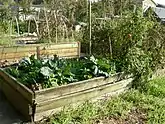Raised-bed gardening
Raised-bed gardening is a form of gardening in which the soil is enclosed in three-to-four-foot-wide (1.0–1.2 m) containment units ("beds"), which are usually made of wood, rock, or concrete and which can be of any length or shape. The soil is raised above the surrounding soil[1] (approximately six inches to waist-high) and may be enriched with compost.[2]

Vegetable plants are spaced in geometric patterns, much closer together than in conventional row gardening.[2] The spacing is such that when the vegetables are fully grown, their leaves just barely touch each other, creating a microclimate in which weed growth is suppressed[2] and moisture is conserved.[3]
Overview
Raised beds lend themselves to the development of complex agriculture systems that utilize many of the principles and methods of permaculture. They can be used effectively to control erosion and recycle and conserve water and nutrients by building them along contour lines on slopes.[3] This also makes more space available for intensive crop production.[2] They can be created over large areas with the use of several commonly available tractor-drawn implements and efficiently maintained, planted and harvested using hand tools.
This form of gardening is compatible with square foot gardening and companion planting.
Circular raised beds with a path to the center (a slice of the circle cut out) are called keyhole gardens.[4] Often the center has a chimney of sorts built with sticks and then lined with feedbags or grasses that allows water placed at the center to flow out into the soil and reach the plants' roots.
A self watering raised bed known as a wicking bed is particularly beneficial in dry climates and are often made by converting Intermediate bulk container (IBC's).
Materials and construction
Vegetable garden bed construction materials should be chosen carefully. Some concerns exist regarding the use of pressure-treated timber.[5] Pine that was treated using chromated copper arsenate or CCA, a toxic chemical mix for preserving timber that may leach chemicals into the soil which in turn can be drawn up into the plants, is a concern for vegetable growers, where part or all of the plant is eaten. If using timber to raise the garden bed, ensure that it is an untreated[2] hardwood to prevent the risk of chemicals leaching into the soil. A common approach is to use timber sleepers joined with steel rods to hold them together. Another approach is to use concrete blocks, although less aesthetically pleasing, they are inexpensive to source and easy to use.
On the market are also prefab raised garden bed solutions which are made from long lasting polyethylene that is UV stabilized and food grade so it will not leach undesirable chemicals into the soil or deteriorate in the elements. A double skinned wall provides an air pocket of insulation that minimizes the temperature fluctuations and drying out of the soil in the garden bed. Sometimes raised bed gardens are covered with clear plastic to protect the crops from wind and strong rains.[6] Pre-manufactured raised bed gardening boxes also exist.[1] There are variants of wood, metal, stone and plastic.
Benefits
Raised beds produce a variety of benefits: they extend the planting season,[2] they can reduce weeds if designed and planted properly,[2] and they reduce the need to use poor native soil. Since the gardener does not walk on the raised beds, the soil is not compacted and the roots have an easier time growing.[6] Waist-high raised beds enable the elderly and physically disabled to grow vegetables without having to bend over to tend them.[6]
Gallery
 Picardo Farm, Wedgwood neighborhood, Seattle, Washington: A community allotment garden with raised beds for the physically disabled.
Picardo Farm, Wedgwood neighborhood, Seattle, Washington: A community allotment garden with raised beds for the physically disabled.

 Raised garden bed with lettuce in Don Det, Laos.
Raised garden bed with lettuce in Don Det, Laos. Raised garden beds with painted wooden edgings at Wise Words Community Garden in Mid-City, New Orleans.
Raised garden beds with painted wooden edgings at Wise Words Community Garden in Mid-City, New Orleans. Preparing raised flower-beds in a private garden in Brastad, Sweden.
Preparing raised flower-beds in a private garden in Brastad, Sweden.
See also
- Kitchen garden
- Therapeutic garden
- Hügelkultur: another type of raised bed
- Waru Waru – A traditional Quechua, pre-Inca system involving raised beds
References
- Hughes, Megan McConnell (2010). Better Homes & Gardens Vegetable, Fruit & Herb Gardening. Wiley. pp. 68–69. ISBN 9780470638569. Retrieved March 2, 2012. ISBN 978-0-470-63856-9
- Nones, Raymond (2010). Raised-Bed Vegetable Gardening Made Simple. Countryman Press. ISBN 9781581578508. Retrieved March 2, 2012. ISBN 978-0-88150-896-3
- Millarville Horticultural Club (1982). Gardening under the arch: homespun hints and money saving tips from the rigorous high country of Alberta's chinook zone. The Club. pp. 291–292. ISBN 9781894898430. Retrieved March 2, 2012. ISBN 0-88925-406-0
- Kemery, Ricky (January 29, 2012). "Unlock your creativity with keyhole garden". The Journal Gazette. Archived from the original on 2014-07-14. Retrieved March 6, 2012.
- Lively, Ruth. "Does Pressure-Treated Wood Belong in Your Garden?". Fine Gardening Magazine. Retrieved March 6, 2012.
- Whiting, David E. (1991). The desert shall blossom: a comprehensive guide to vegetable gardening in the Mountain West. Horizon. pp. 41–42. ISBN 9780882904184. Retrieved March 2, 2012. ISBN 0-88290-418-3
Bibliography
- Bird, Christopher (2001). Cubed Foot Gardening: Growing Vegetables in Raised, Intensive Beds. Lyons Press. ISBN 9781599215914. Retrieved March 2, 2012. ISBN 1-58574-312-7
- Linhart, Rita & Richardson, Antoinette (2012). Raised Bed Gardening - low cost, high yield and simply done. Books on Demand. ISBN 978-3837018417. ISBN 978-3-8370-1841-7
External links
- The Synergistic Garden—A video by Emilia Hazelip, which provides practical information on how to garden with raised beds.
- Appeal: Keyhole gardening saves lives in world's most eroded land